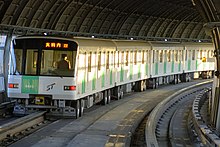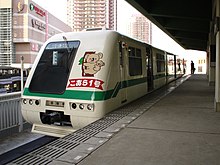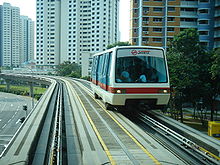Guardrail track
Guardrail tracks are rail systems whose vehicles are kept on track by a guide rail placed in the middle of the track. Originally they were also designed for traffic on railway tracks, but the wagons of today's guardrails roll on rubber tires .
development
Even with slight deviations from the specified track, too high a speed or external influences, there is a risk that the flanges of the wheels of a railway vehicle lose contact with the rails. The guardrail was supposed to solve this problem of the risk of derailment by using a guardrail installed in the middle of the track to keep the vehicle on track by means of guide rollers.
The idea of the guardrail track came from the engineer Franz Kruckenberg , who later became famous for the rail zeppelin he developed . In September 1928, together with Curt Stedefeld, he received a patent for a train, the vehicle of which was positively guided by horizontally mounted guide rollers on both sides of a guardrail in the middle of the track. Its steel support wheels could therefore run on the rails without flanges . The purpose of the design should be to make a high-speed long-distance railcar safe from derailment. Since Kruckenberg viewed disruptive weather conditions such as ice and snow as insurmountable problems, he did not pursue the project any further.
Fritz Heyner, an employee of Kruckenberg, also received a similar patent in September 1928. The vehicles in his system had rubber-tyred wheels that ran on track bars made of wood, concrete or iron.
Heiner Kuch and Heinrich Jacobi are considered to be the actual inventors of the guardrail system. On September 30th, 1933, Kuch received a patent for the “compulsory wheel steering by means of a guide roller resting on a central guide rail”. It provided for a level concrete pavement; On either side of the guardrail there were two guide rollers of different diameters, which were attached at different heights. This arrangement was intended to avoid derailing even in highly elevated curves. Instead of using a direct route, the steering forces should be transmitted to the bogies via lever and spring linkages . As a result, the carrying wheels adjusted radially without jerking when transitioning into a curve. Since there were no tires suitable for high speeds at the time, rimless steel cones should be used at speeds above 150 km / h, which roll on flat rails. These cones were attached to the outside of the rubber wheels and ran unloaded at lower speeds.
As early as March 1930, Kuch had presented a 1:33 scale model of his railway; it was not produced in original size. The development, which was interrupted by the Second World War, continued after 1945. In 1951 he received a patent for diagonally cut or overlapping rail ends, which should solve the problem of rail joints and gaps. In 1953 at the German Transport Exhibition in Munich , a model of his guardrail run at a scale of 1:33 ran on an approximately 200 m long system .
In the 1960s, Kuch created the "improved guardrail", the vehicles of which could also be guided by side barriers or controlled by hand. With this he had devised the principle of the track bus , but also other railways with lateral track guidance ( VAL , AGT ). In 1962, in order to make the roadway usable for the rest of the traffic, he relocated the middle rail into the road surface. This solution can be found today at Tramways sur pneumatiques .
Realized tracks
Japan



In the Japanese city of Sapporo , one of the first - and still the most extensive - guardrail was built. The planning for the subway there goes back to 1962, the construction of which began in 1969 without the conventional wheel-rail system. Shortly before the start of the Winter Olympics , the Namboku line was opened on December 16, 1971. Their trains run on gas-filled rubber tires on a concrete track with a surface made of epoxy resin . The track is guided by guide wheels pressed onto a center rail with a simple T-profile. The railcars are supplied with a direct voltage of 750 V via a busbar on the side .
The rubber tires were chosen because of the lower vibrations and the lower noise, but above all because of the higher friction values. The latter lead to better acceleration and braking behavior, which increases the travel speed at short distances between stops. In addition, steeper ramps can be used than with the conventional wheel-rail system.
In 1976 and 1988, two more routes were put into operation in Sapporo with the Tōzai Line and the Tōhō Line. There, too, the trains are guided by guardrails. Their lanes consist of steel plates that lie on cross ties or - on some sections of the Tōzai line - directly on the concrete. The trains on these two lines receive their traction current (1500 V DC) via overhead lines .
A guardrail was built in the Yūkarigaoka district of the city of Sakura in 1982/83. The 4.1 km long Yūkarigaoka Line is operated with 750 V DC and has six stations.
The 7.4 km long Tokadai Line in Nagoya , opened on March 25, 1991, was a guardrail with end loops , the four-car trains of which were operated by drivers. On September 30, 2006, the railway, also known as the "Peachliner", was closed.
United States
In the 1960s, the USA began an intensified search for alternative transport systems, some of which were very futuristic in their implementation. Initially, airports and amusement parks were primarily interested in the solutions offered. When the government agencies promised extensive state funding, the interest of local authorities also grew.
The system developed by Westinghouse Transportation Systems and built at its Pittsburgh location corresponds to the principle of the guardrail runway . There he made several plants for relatively small vehicles of the type people movers like the C-100 and its further CX-100 in 1994. An adaptable track alignment is by a turning circle of only 22 meters and a slope can hold up possible to 10%; the roadway can be elevated, at ground level or in a tunnel. Train formations of up to four individual vehicles can be formed.
The system was first used in 1971 at Tampa International Airport , in 1973 the Seattle-Tacoma International Airport and in 1980 the Hartsfield-Jackson Atlanta International Airport . In 1981 the Orlando International Airport came , in 1983 McCarran International Airport ( Las Vegas ), in the 1990s the airports Pittsburgh International Airport , Denver International Airport , George Bush Intercontinental Airport ( Houston ), since 2000 the San Francisco International Airport and Dallas / Fort Worth International Airport added.
In 1986 the Miami-Dade Metromover was opened, a public guardrail in downtown Miami , Florida .
Germany
The only guardrail in Germany is the SkyLine at Frankfurt am Main Airport . This fully automatic CX-100 passenger transport system was put into operation in 1994. In 1996, ten more were added to the eight vehicles originally built in Pittsburgh. In 2003 over 7 million passengers used the train, the two-car trains of which consist of one vehicle for international passengers and one for Schengen passengers .
rest of the world
Guardrails now exist in several countries.
- Great Britain : London Stansted Airport (1991)
- Malaysia : Kuala Lumpur International Airport (1998)
- Singapore : Bukit Panjang LRT (1999)
- Italy : Aeroporto di Roma-Fiumicino (1999)
- Spain : Aeropuerto Adolfo Suárez Madrid-Barajas (2006)


